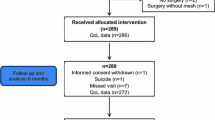Abstract
Purpose
The aim of this study was to assess the relationship between long term quality of life (QoL), patient satisfaction, and Pelvic Organ Prolapse Quantification (POPQ) scores following anterior vaginal repair with mesh.
Methods
This cross-sectional study included 127 patients who underwent anterior pelvic floor repair with mesh and were assessed 1.03–2.69 years post surgery. One hundred and four women completed the King’s Health Questionnaire (KHQ), the Sheffield Prolapse Symptoms Questionnaire, the EurolQoL EQ-5D, and the Patient Satisfaction Index. POPQ scores were recorded for up to 1 year.
Results
Patients reported good current QoL and high patient satisfaction. POPQ Aa and Ba scores showed significant improvements from a pre-surgery median of +1 to a median of −3 at 12-month follow-up (P < .001). Patient satisfaction was inversely correlated with Aa scores at 12 months (r s = −.360, n = 49, P < .011). There were high QoL scores at an average 2 years after anterior compartment mesh repair.
Conclusions
QoL outcomes were good. There was a significant relationship between Aa scores and patient satisfaction, suggesting that this outcome is a key to patient satisfaction.

Similar content being viewed by others
References
Haylen BT, de Ridder D, Freeman RM, Swift SE, Berghmans B, Lee J, Monga A, Petri E, Rizk DE, Sand PK, Schaer GN (2010) An International Urogynecological Association (IUGA)/International Continence Society (ICS) joint report on the terminology for female pelvic floor dysfunction. Int Urogynecol J 21:5–26
Hiltunen R, Nieminen K, Takala T, Heiskanen E, Merikari M, Niemi K et al (2007) Low-weight polypropylene mesh for anterior vaginal wall prolapse: a randomized controlled trial. Obstet Gynecol 110:455–462
Nguyen JN, Burchette RJ (2008) Outcome after anterior vaginal prolapse repair: a randomized controlled trial. Obstet Gynecol 111:891–898
Sand PK, Koduri S, Lobel RW, Winkler HA, Tomezsko J, Culligan PJ, Goldberg R (2001) Prospective randomized trial of polyglactin 910 mesh to prevent recurrence of cystoceles and rectoceles. Am J Obstet Gynecol 184:1357–1362
Weber AM, Walters MD, Piedmonte MR, Ballard LA (2001) Anterior colporrhaphy: a randomized trial of three surgical techniques. Am J Obstet Gynecol 185:1299–1304
Maher C, Feiner B, Baessler K, Adams EJ, Hagen S, Glazener CM (2010) Surgical management of pelvic organ prolapse in women. Cochrane Database Syst Rev 4:CD004014
Altman D, Väyrynen T, Ellström Engh M, Axelsen S, Falconer C (2011) Anterior colporrhaphy versus transvaginal mesh for pelvic-organ prolapse. New Engl J Med 364:1826–1836
Vollebregt A, Fischer K, Gietelink D, van der Vaart CH (2011) Primary surgical repair of anterior vaginal prolapse: a randomised trial comparing anatomical and functional outcome between anterior colporrhaphy and trocar-guided transobturator anterior mesh. BJOG 118:1518–1527
Fatton B, Amblard J, Debodinance P, Cosson M, Jacquetin B (2007) Transvaginal repair of genital prolapse: preliminary results of a new tension-free vaginal mesh (Prolift technique)—a case series multicentric study. Int Urogynecol J Pelvic Floor Dysfunct 18:743–752
Elmér C, Altman D, Engh ME, Axelsen S, Vayrynen T, Falconer C (2009) Trocar-guided transvaginal mesh repair of pelvic organ prolapse. Obstet Gynecol 113:117–126
Abdel-Fattah M, Ramsay I (2008) Retrospective multicentre study of the new minimally invasive mesh repair devices for pelvic organ prolapse. BJOG 115:22–30
Feiner B, Jelovsek JE, Maher C (2009) Efficacy and safety of transvaginal mesh kits in the treatment of prolapse of the vaginal apex: a systematic review. BJOG 116:15–24
Rogers R (2011) To Mesh or Not to Mesh: current Debates in Prolapse Repair Fueled by the U.S. Food and Drug Administration Safety Notification. Obstet Gynecol 118:771–773
Bump RC, Mattiasson A, Bø K, Brubaker LP, DeLancey JO, Klarskov P et al (1996) The standardization of terminology of female pelvic organ prolapse and pelvic floor dysfunction. Am J Obstet Gynecol 175:10–17
The EuroQol Group (1990) EuroQol—a new facility for the measurement of health-related quality of life. Health Policy 16:199–208
Bradshaw HD, Hiller L, Farkas AG, Radley S, Radley SC (2006) Development and psychometric testing of a symptom index for pelvic organ prolapse. J Obstet Gynaecol 26:241–252
Kelleher CJ, Cardozo LD, Khullar V, Salvatore S (1997) A new questionnaire to assess the quality of life of urinary incontinent women. Br J Obstet Gynaecol 104:1374–1379
Digesu GA, Salvatore S, Chaliha C, Athanasiou S, Milani R, Khullar V (2007) Do overactive bladder symptoms improve after repair of anterior vaginal wall prolapse? Int Urogynecol J Pelvic Floor Dysfunct 18:1439–1443
Moore RD, Beyer RD, Jacoby K, Freedman SJ, McCammon KA, Gambla MT (2010) Prospective multicenter trial assessing type I, polypropylene mesh placed via transobturator route for the treatment of anterior vaginal prolapse with 2-year follow-up. Int Urogynecol J Pelvic Floor Dysfunct 21:545–552
de Tayrac R, Devoldere G, Renaudie J, Villard P, Guilbaud O, Eglin G, French Ugytex Study Group (2007) Prolapse repair by vaginal route using a new protected low-weight polypropylene mesh: 1-year functional and anatomical outcome in a prospective multicentre study. Int Urogynecol J Pelvic Floor Dysfunct 18:251–256
Carey M, Higgs P, Goh J, Lim J, Leong A, Krause H et al (2009) Vaginal repair with mesh versus colporrhaphy for prolapse: a randomised controlled trial. BJOG 116:1380–1386
Culligan PJ, Littman PM, Salamon CG, Priestley JL, Shariati A (2010) Evaluation of a transvaginal mesh delivery system for the correction of pelvic organ prolapse: subjective and objective findings at least 1 year after surgery. Am J Obstet Gynecol 203:506.e1–506.e6
Ternent L, Vale L, Buckley B, Glazener C (2009) Measuring outcomes of importance to women with stress urinary incontinence. BJOG 116:719–725
Conflict of interest
We declare that we have no conflict of interest.
Author information
Authors and Affiliations
Corresponding author
Rights and permissions
About this article
Cite this article
Hefni, M., Barry, J.A., Koukoura, O. et al. Long-term quality of life and patient satisfaction following anterior vaginal mesh repair for cystocele. Arch Gynecol Obstet 287, 441–446 (2013). https://doi.org/10.1007/s00404-012-2583-0
Received:
Accepted:
Published:
Issue Date:
DOI: https://doi.org/10.1007/s00404-012-2583-0




